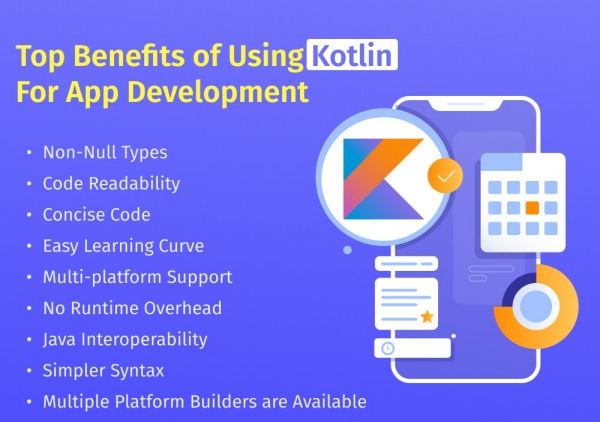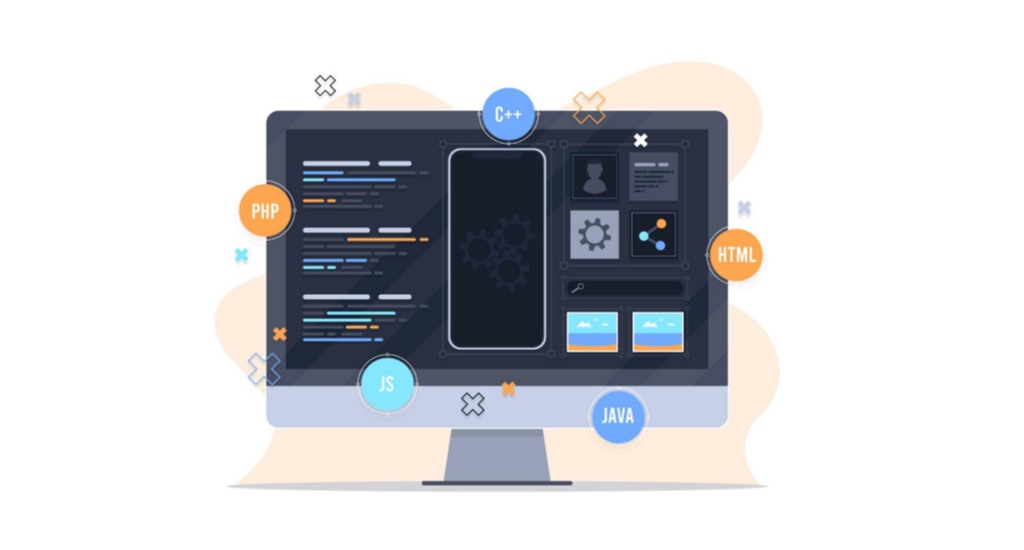Do you know?
Kotlin ranked 4th in the list of most beloved languages in 2020 with 62.9% votes. In just three years, now the top 7.8% of the industry experts are using Kotlin. The top companies like Google, NetFlix, Amazon, and Trello use this language and leverage its benefits.

There’s a good chance you already know how powerful this language can be. But if you’re not sure why it’s the most popular choice in the industry, then you’ve come to the right place. Below are some of the top reasons why Kotlin is the most preferred language among developers today.
The Top Benefits of Using Kotlin For App Development

1. Non-Null Types
One of Kotlin’s defining features that separate it from other JVM languages like Java and Scala is its nullability checking. It means that values of a variable will either be null or hold an instance of an object/data type. Any variable in Kotlin can be declared nullable or non-nullable. The compiler won’t allow you to specify a value to a non-nullable variable that has been marked as null.
So, if there is even a single chance of your variable being set to null, you need to declare it as such. While there may not be much use case for assigning variables with specific types but marking them as nullable, there are enough reasons why one should stick to non-null kinds throughout their application code.
2. Code Readability
Programming languages can be broadly classified into declarative and imperative. Imperative programming deals with describing computation in a manner that focuses on procedure and how to perform tasks, while declarative programming deals with writing out results or what needs to be done for a certain outcome. Kotlin belongs to the former category and happens to be open source.
Its increasing adoption by tech giants like Pinterest, Basecamp, and Uber is indicative of its rising popularity. The reason for choosing Kotlin over other mainstream programming languages lies in its code readability features. It helps developers write code faster while offering similar functionality as Java, which developers are already acquainted with.
The learning curve associated with moving from Java to Kotlin is relatively tiny since syntax-wise, there are no significant changes between both languages. Finally, Kotlin code remains concise even when complex functionalities are due to DSLs (domain-specific language).
3. Concise Code
One of Kotlin’s top-selling points as a programming language is its conciseness. It’s minimal and uses less boilerplate than Java or other languages—it essentially does not need an equivalent to Java’s imports, for example. It means more code can be written and understood in less time and with fewer bugs.
Fewer bugs mean developers spend less time tracking them down, making their work more efficient overall. The fact that it’s so easy to write explicit code in Kotlin makes it even easier to read and understand someone else’s code when you have to dig into it. There are very few situations where such an important quality doesn’t come in handy.
4. Easy Learning Curve
You can learn Kotlin much faster than many other languages. If you’re already familiar with Java, C#, or JavaScript, learning Kotlin will be a piece of cake. It means you can get started on your projects more quickly than if you were using other languages. The rapid learning curve also makes it an excellent language for junior developers looking to prove themselves and earn respect in their careers.
It takes less time to become productive, which equates to higher job satisfaction. Kotlin is one of several JVM-based languages (others include Scala, Clojure). One thing that stands out about Kotlin is its concise code—you get more done in fewer lines. It doesn’t take long before you understand how refreshingly simple Kotlin syntax is compared to similar programming concepts in Java or other languages.
5. Multi-platform Support
Compared to other languages like Swift, Kotlin is supported by Java Virtual Machine (JVM) and can run on multiple platforms. You need not write different codes for mobile applications. Moreover, Kotlin works well with JVM-based languages like Clojure, Scala, and Groovy that are already in use by many Java developers. This makes it easier for them to switch to Kotlin without having to learn a new coding language. Additionally, there are several opportunities for multi-platform Android application development in today’s market if your business utilizes multiple mobile apps.
For instance, companies may require an app for their digital product display and a loyalty card app that runs at POS terminals. Having a single programming language behind both these apps gives businesses tremendous flexibility and cost savings. One team can create two apps from scratch rather than hire separate groups to build them using different programming languages.
6. Multiple Platform Builders are Available
Kotlin was created by JetBrains, which built its first IDE (IntelliJ IDEA) on top of Java. It means that developers can still use all of their existing Java code to build Kotlin applications, including frameworks like Android.
Although you’ll likely want to transition your codebase to Kotlin eventually, there’s no need to rush it—your projects are immediately interoperable with Java so that you can learn Kotlin alongside your existing projects. The best part? Your Kotlin apps can be run on any JVM-compatible platform, including JavaScript! If you don’t have specific technology or platform in mind right now, there’s an ever-growing market for apps and businesses that will support Kotlin going forward.
7. No Runtime Overhead
If you’re coming from a Java background, no worries: because Kotlin and Java are both JVM languages, it’s relatively easy to keep working with existing libraries and frameworks. Plus, you can call out native code written in any platform supported by your choice of JVM (Java, Scala, or Clojure). The combination means that there’s almost no runtime overhead—and getting started is quick! And, if an IDE supports Kotlin, you can write everything in one place without jumping back and forth between IDEs. It’s worth trying for anyone doing serious work on Android.
That said, as much as we like JetBrains as a company, we like open source communities more; Kotlin runs on multiple platforms and has undergone significant development under Google’s leadership. We think those facts will ultimately lead to more support for third-party technologies; currently, those who use those technologies may find themselves coding around library issues due to JetBrains’ tight integration with Google libraries and tools.
8. Java Interoperability
Being a JVM-based language, Kotlin can be used alongside Java. It’s fully interoperable with Java and other JVM languages. If you already have a large team of developers who know how to code in Java but are looking for something new to add to their skill sets, migrating from Java is an excellent idea.
You may even have to look into creating mixed teams that include both Java and Kotlin coders. It’s easier than ever before! All you need is Google’s official blessing.
9. Simpler Syntax
One of Kotlin’s strong points is its syntax. It’s relatively easy to learn, which means you can hire more developers who know how to code in it—therefore, bringing down your training costs. Also, if you have a large team of iOS or Android developers working on an app for you already, they may already be somewhat familiar with Java or Swift. This would make it easier for them to transition into coding in Kotlin instead of learning another new language.
You could then use one joint development base for both platforms and not need multiple teams. For instance, Xamarin uses C#, and NativeScript uses JavaScript; these platforms allow developers to build once and deploy to multiple platforms without needing separate development bases. Kotlin offers similar functionality so that businesses don’t have to hire two different teams with two other languages or use multi-platform frameworks such as Xamarin and NativeScript. JavaScript is used as an underlying layer for cross-platform compatibility.
Final Words
All in all, you can start developing a new feature, a mobile application, or a new website on your own. It doesn’t have to be that difficult! Start your project today and hire Kotlin developers for it. There are so many good things about using Kotlin and Android Studio because they are very convenient.
